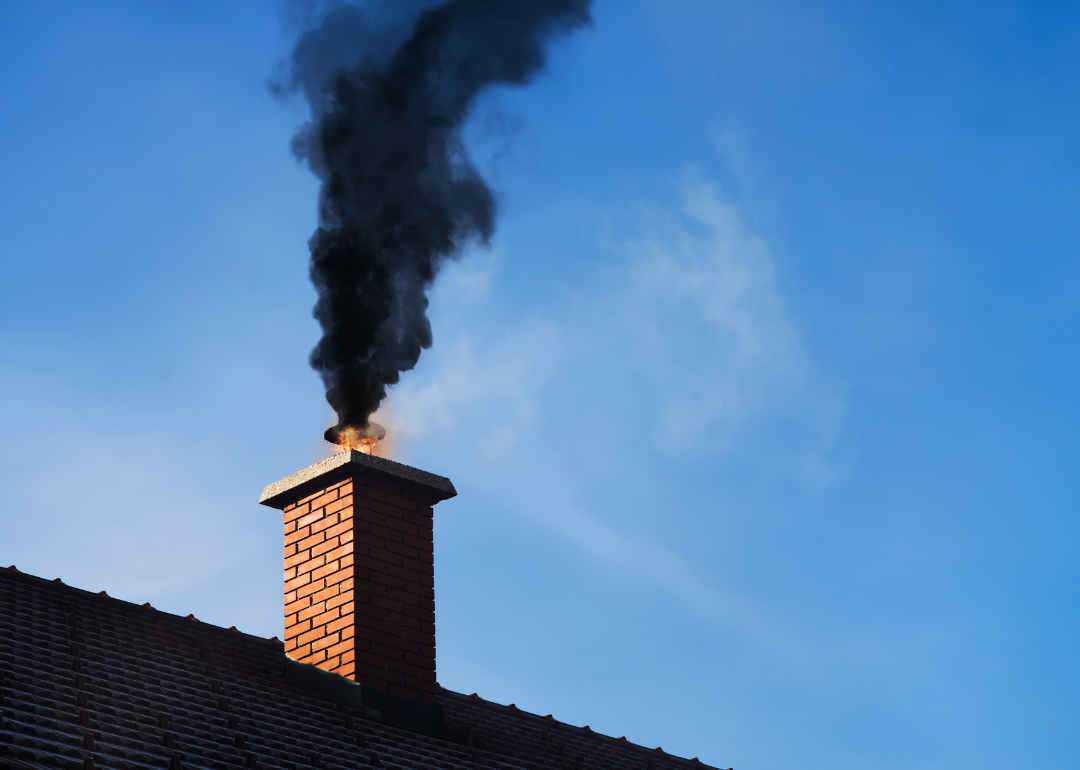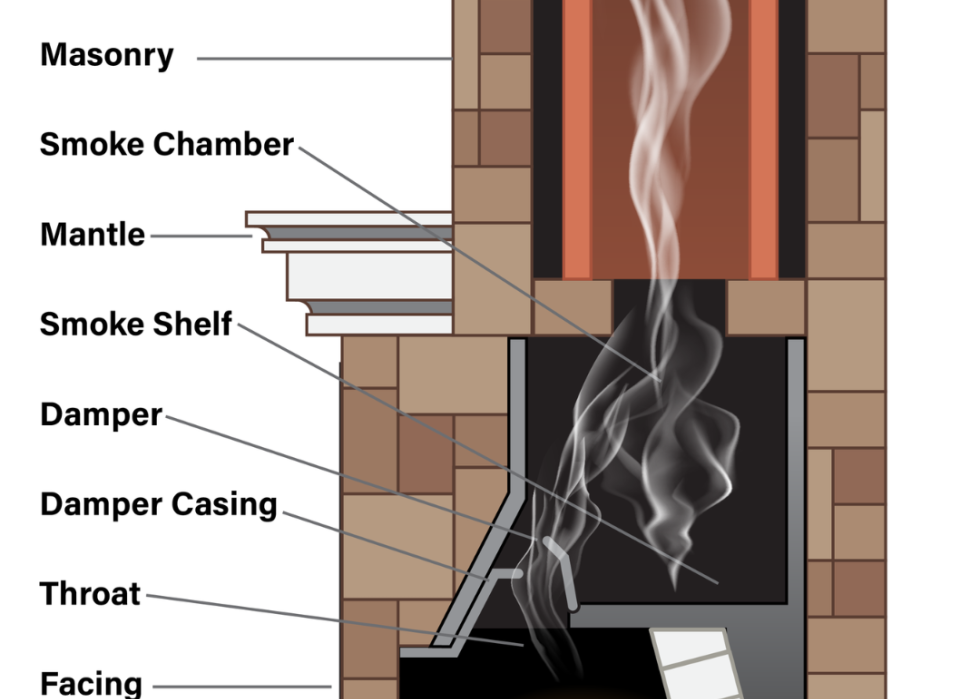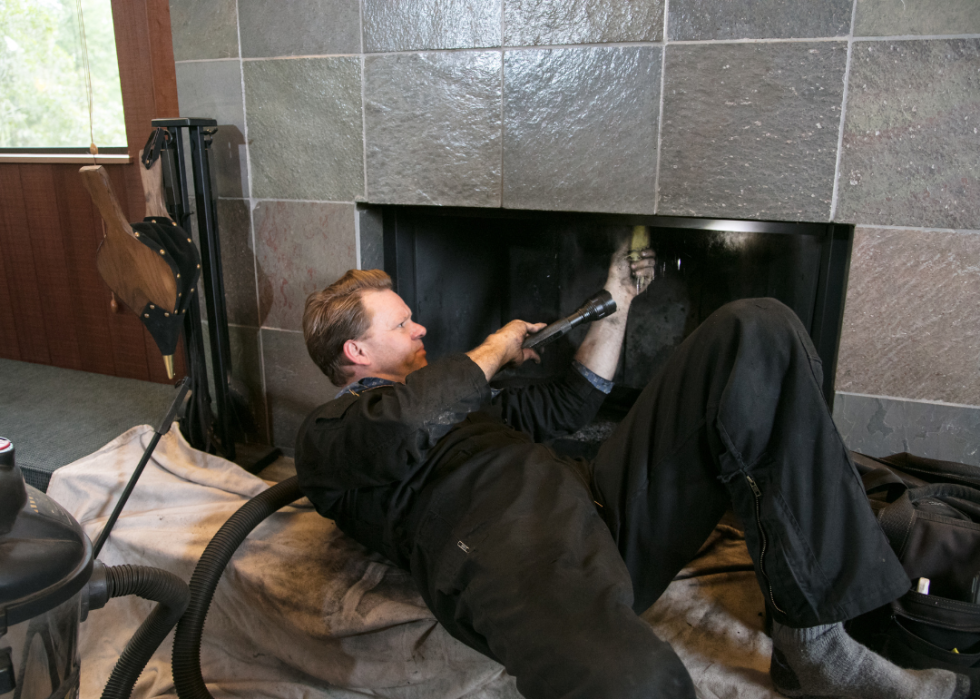
11 ways to prevent a chimney fire
11 ways to prevent a chimney fire
Before the snowy season sets in and you're curling up in front of a cozy fire, it is time to think about ways you can prevent chimney fires in your home. Knowing the best safety practices helps reduce the buildup of creosote in your chimney flue and protects your home from chimney fires.
From installing a chimney cap to knowing the best type of kindling to use, Roof Gnome offers 11 ways to prevent a chimney fire and keep your home safe.

11 ways to prevent a chimney fire
Fire departments respond to over 40,000 residential fires caused by heating equipment every year. The National Fire Protection Agency (NFPA) reports that dirty equipment is the leading cause of home heating fires.
Creosote, a by-product of combustion, is your worst enemy for keeping your chimney clean, and creosote buildup causes most chimney fires. Follow some easy safety measures to reduce your risk of a chimney fire.
1. Get a chimney inspection
They say don't play with fire and playing with fire is exactly what you are doing if you fall behind on your yearly chimney inspection. Experts recommend having your chimney inspected once per year to check for damage and potential hazards that could cause major problems down the road.
Chimney inspectors look for the following signs of damage:
- Cracks
- Damaged chimney liner
- Broken flue tiles
- Debris
- Improper installation
In some cases, a chimney sweep will inspect your chimney while cleaning it. However, always ask if a chimney inspection is included in your service.
2. Have your chimney cleaned annually
There's nothing like routine maintenance to prevent a chimney fire, but it is easy to let chimney maintenance slide. The Chimney Safety Institute of America (CSIA) recommends having your chimney cleaned once per year to remove creosote buildup and protect your home from fire.
A chimney should never have more than 1/8 inch of creosote buildup coating the walls. If you notice a deep creosote layer in your chimney, schedule a professional cleaning appointment as soon as possible before using your fireplace.
3. Remove ash from your fireplace
Fires leave behind gray ash and charred wood. Once your fire is out and cool to the touch, sweep the ash out of your fireplace. Leaving piles of ash in your fireplace increases your risk of a chimney fire. Lighting a fire in a fireplace full of ash causes the ashes to rise and stick to your flue liner, creating more creosote.
Additionally, ash-coated chimneys trap smoke and hazardous gasses like carbon monoxide.
4. Burn dry firewood
Using the right type of kindling has a big impact on how much creosote a fire generates and how well a fire burns.
Follow these tips for selecting the best firewood:
- Always burn dry, seasoned wood. Seasoned wood burns more effectively and reduces harmful byproducts.
- Skip the fire if your wood is damp. Burning wet wood produces smoke and creosote.
- Don't burn driftwood. The salt content in driftwood damages a chimney's structure.
- Avoid evergreen wood. Burning evergreen wood produces more smoke.
- Use hardwoods. Choose hardwoods instead of softwoods. Hardwoods burn low and hot, last longer, and produce less creosote.
5. Burn creosote logs
Creosote logs should never be used as a replacement for chimney cleaning. However, when used in addition to cleaning as part of your chimney maintenance plan, they help break down creosote and tar buildup, reducing your risk of a chimney fire and making it easier to clean your chimney.
6. Only burn wood
People burn wood and not other materials for a reason. Never burn anything except wood in your fireplace, and never use lighter fluids or liquid accelerants to start your fire. Other materials and objects produce harmful byproducts.
Some of the best types of firewood include:
- Ash
- Birch
- Maple
- Oak
7. Install a chimney cap
Debris in your chimney poses a danger and can cause a chimney fire. Chimney caps resemble mini roofs covering your chimney's opening. They have built-in mesh to deflect debris and allow smoke and hazardous gasses to escape.
Chimney caps prevent debris and animals from entering your fireplace and keep sparks from starting a fire on your property. Call a professional animal removal expert if you suspect there are trapped birds or other wildlife inside your chimney.
8. Add blue liner
Flue liners are made of ceramic or metal and insulate the interior walls of your chimney. For the best results, install a stainless steel flue liner that can withstand very high temperatures.
9. Ensure your chimney has adequate airflow
Creosote buildup increases with poor airflow, and your fireplace needs proper ventilation to work properly. Keep your damper open whenever there is a fire to release smoke and provide oxygen.
10. Create a perimeter around your fireplace
Fire is as beautiful as it is dangerous, and it is important to create a perimeter around your fireplace to keep flammable materials at a safe distance. Here are some flammable objects you should store outside of your fireplace perimeter:
- Books
- Flammable liquids
- Lighter fluid
- Blankets
- Paper products
11. Never leave a fire unattended
Never light a fire you can't watch. Always extinguish your fire before leaving your house or going to bed. If a fire gets out of control while you are asleep or away from home, it could cause a whole house fire.

Signs your chimney needs cleaning
All chimneys should be cleaned at least once per year. Watch for these signs your chimney needs cleaning, and schedule a chimney sweep appointment as soon as possible:
- Creosote buildup
- Soot particles
- You have trouble igniting a fire
- You smell smoke, tar, or asphalt even when there isn't a fire
- Your fire creates loud cracking or popping noises
- Smoke buildup
- Wildlife presence
- Allergy or respiratory issues
How frequently should you clean your chimney?
The NFPA recommends having your chimney professionally cleaned at least once per year, or more with frequent usage. The best times to clean your chimney are in the spring, summer, or early fall, resulting in cheaper labor costs and easier scheduling.
Cost of cleaning a chimney
The national average cost for a chimney cleaning is $230, with costs for hiring a chimney sweep ranging between $110 to $290.
Some additional factors may increase the cost of hiring a chimney sweep, including:
- Wildlife removal
- Bird nest removal
- Excessive creosote buildup
Keeping up with your chimney maintenance and making sure that the creosote buildup in your chimney doesn't get out of hand is also a good way to keep service prices lower. If your chimney sweep has to clean an excessive amount of creosote from your smoke chamber, your costs could increase to as much as $850.
Signs of a chimney fire
Chimney fires can reach temperatures over 2,000 degrees Fahrenheit and can cause serious structural damage, including melting or cracking. Unfortunately, fire can sneak up on even the most mindful homeowner. Watch for these telltale signs of a chimney fire:
- Loud cracking or popping sounds
- Roaring sounds resembling a passing train or airplane
- Intense smell
- Dense, black smoke
- Flames at the top of your chimney
Fires produce creosote, a tar-like substance that sticks to the sides of your chimney flue and clogs its pathway. Creosote normally appears as a black or brown flaky layer, while old, hardened creosote looks shiny.
What to do in the event of a chimney fire
Follow these steps if you detect a chimney fire:
- Evacuate your house.
- Call the fire department.
- If it is safe, close the chimney damper or doors to cut off the fire's air supply.
- Use your garden hose to spray your roof and prevent the chimney fire from spreading.
FAQs about ways to prevent chimney fires
Can I leave my flue open?
No. Leaving your flue open leads to carbon monoxide buildup and other fire hazards. Closing your flue helps regulate the temperature of your home.
Does baking soda put out fires?
Yes. Sodium bicarbonate, or baking soda, is effective at putting out fires and is used in fire extinguishers. When you're ready to put out your fire, follow these simple steps:
• Use a poker to spread out the embers and burning wood in your fireplace.
• Use a fireplace shovel to bury the embers and wood in cool ashes until all the flames have gone out.
• Cover the area with a layer of baking soda.
Can I clean my chimney myself?
Yes. It is best to hire a professional chimney sweep, but you can DIY clean your chimney. However, a trained CSIA-certified professional more efficiently removes creosote buildup and identifies potential problems.
Keep your chimney free of fires
There are several ways to prevent a chimney fire, but keeping your chimney clean with a routine chimney maintenance plan is the best method for a stress-free chimney.
This story was produced by Roof Gnome and reviewed and distributed by Stacker Media.



